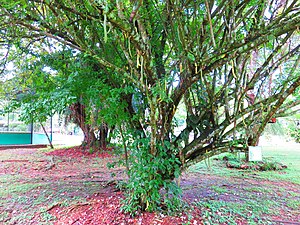Parmentiera cereifera
| Parmentiera cereifera | ||||||||||||
|---|---|---|---|---|---|---|---|---|---|---|---|---|

Parmentiera cereifera |
||||||||||||
| Systematics | ||||||||||||
|
||||||||||||
| Scientific name | ||||||||||||
| Parmentiera cereifera | ||||||||||||
| Seem. |
Parmentiera cereifera or the candle tree is a tree in the trumpet family from Central America to the Caribbean .
description
Parmentiera cereifera grows as an evergreen , small and often multi-stemmed tree up to 6–7 meters high. The trunk diameter reaches about 20 centimeters. The brownish-grayish, slightly cracked bark is flaking off in small flakes.
The mostly opposite, rarely whorled and stalked leaves are usually threefold. The mostly winged petiole is up to 5–6 inches long. The mostly entire (individual teeth can occur), leathery leaves are (almost) sessile, up to 7–8 inches long and up to 3–4 inches wide. The egg-shaped to elliptical or rhombic, more rarely obovate, almost bald leaf blade is short running down and at the tip it is rounded to rounded or pointed, pointed to pointed. The young leaves are roughly serrated.
The flowers appear singly or in tufts up to four, stem or knot, kauli- , ramiflor. The stalked and five-fold, relatively large, cup-shaped, hermaphrodite flowers with a double flower envelope and a wide throat are white-yellowish, greenish. The bald, greenish sepals are spatially fused, split on one side and up to 3–4.5 centimeters long. The overgrown, about 4-6 centimeters long crown with spreading, ribbed and wide, rounded, about 1 centimeter long lobes is two-lipped. There are 4 just protruding and unequal long, didynamic stamens in the middle of the corolla tube and a short staminodium. The two-chambered and narrow-cone-shaped ovary is on top with a long stylus with a two-lobed stigma . There is a meaty discus present.
There are 30-60 or more centimeters long, narrow, up to 2.5 centimeters wide, almost straight and drooping, greenish-yellow to orange-yellow, waxy, smooth, many-seeded, short-pointed fruits, berries (armored berries ) that look like "Candles" formed. They are slightly to weakly ribbed with a firm skin. The many small, about 2.5-3.5 millimeters large and narrowly winged, smooth seeds, with "slimy wings", lie in the middle, in two rows in a fragrant, yellow and fleshy, fibrous pulp.
use
The little-used, cucumber-like fruits are edible, they can be used raw or cooked. The tree is mostly used as an ornamental plant.
The bark and roots are used medicinally.
literature
- JW Kadereit : The Families and Genera of Vascular Plants. Vol. VII: Flowering Plants Dicotyledons , Springer, 2004, ISBN 978-3-642-62200-7 (Reprint), p. 37 f.
- TK Lim: Edible Medicinal and Non-Medicinal Plants. Volume 1: Fruits , Springer, 2012, ISBN 978-90-481-8660-0 , p. 512 ff.
- F. Raymond Fosberg, Marie-Hélène Sachet, Royce L. Oliver: Flora of Micronesia. 5: Bignoniaceae-Rubiaceae , Smithsonian Contributions to Botany Number 81, Smithsonian Inst. Press, 1993, p. 10, online at biodiversitylibrary.org.
- Fieldiana. No. 41, Flora Costaricensis, 2000, pp. 140 ff, online at biodiversitylibrary.org.
Web links
- Parmentiera cereifera at Useful Tropical Plants.
- Parmentiera cereifera at PlantSystematics (pictures).
